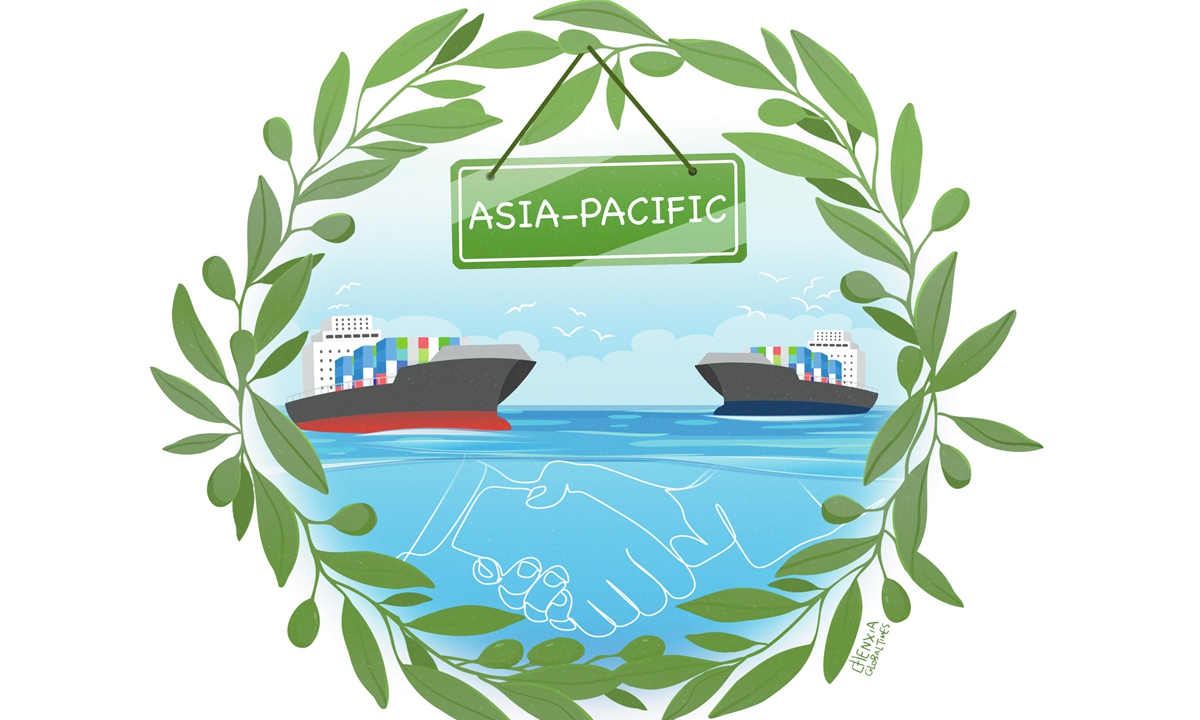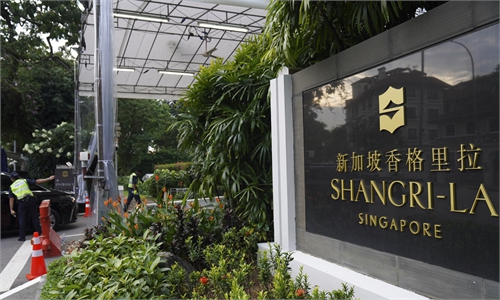Stability of Asia-Pacific stems from inclusive cooperation, not zero-sum competition

Illustration: Chen Xia/GT
Editor's Note:
As the 22nd Shangri-La Dialogue concludes in Singapore on Sunday, regional security issues, from the Taiwan Straits to the South China Sea and beyond, have once again taken center stage in global discourse. Among many concerns, the widening rift between major powers, the persistent tension in maritime hotshots and the growing involvement of non-regional actors have sparked broad debate on the future of the Asia-Pacific security architecture. Against this backdrop, Global Times (GT) reporter Xia Wenxin talked with Peter T.C. Chang (Chang), former deputy director of the Institute of China Studies at the University of Malaya and a research associate at the China-Malaysia Friendship Association, on Asia-Pacific security, the evolution of the new US government's strategy in the region and China-Malaysia cooperation to maintain peace and stability in the region.
GT: Recently, the India-Pakistan border conflict has again stirred up concerns in the situation in South Asia. Do you think the shadow of conflict is creeping closer to the Asia-Pacific? In your view, what is the greatest security risk or threat currently facing the region?
Chang: The recent India-Pakistan border flare-up has heightened concerns about regional stability in South Asia, with far-reaching implications. Both nations are nuclear-armed, and any escalation could affect broader regional dynamics.
However, the most pressing security threat facing the Asia-Pacific today is the escalating China-US rivalry. Tensions over the Taiwan Straits, the South China Sea, the trade war and technological decoupling are fueling military build-up and undermining regional stability. This greater power struggle pressures smaller nations to align with one side, threatening regional cohesion and increasing the risk of miscalculation or conflict. While localized conflicts like India-Pakistan are serious, it's this broader geopolitical rivalry that poses the greatest long-term challenge to Asia-Pacific stability.
GT: At the recently concluded 22nd Shangri-La Dialogue, US Defense Secretary Pete Hegseth introduced an outline of the US "Indo-Pacific Strategy" under the new administration. What are the key similarities or differences in this strategy compared with previous administrations, especially regarding China policy?
Chang: The primary similarity is the continued framing of China as the central strategic challenge. However, the current US government is adopting a more aggressive approach to contain China, which is evident in the escalating trade war and harsh sanctions against Chinese technology firms. An "Indo-Pacific Strategy" under the new US government is more economically aggressive, militarily confrontational and unpredictable in diplomacy compared to the previous administration's alliance-based approach. The risk of sudden escalation, particularly over sensitive issues like Taiwan and the South China Sea, could rise under the current US administration.
GT: What is your assessment of the role that non-regional powers are playing - or seeking to play - in the Asia-Pacific security landscape? What kind of impact do you think this has on the region?
Chang: The US, through its "Indo-Pacific Strategy," asserts its presence by strengthening alliances (such as with Japan, South Korea and Australia), deepening security partnerships (like the Quad and AUKUS), purportedly to promote freedom of navigation in contested waters, especially the South China Sea. The EU has also shown interest in the region's stability, emphasizing maritime security and economic resilience.
The impact of non-regional engagements in the Asia-Pacific is mixed. On the one hand, they can help balance regional power dynamics and offer a degree of stability.
On the other hand, the involvement of external powers can intensify geopolitical tensions, drive militarization and escalate regional disputes into global flashpoints. For example, their growing presence in the South China Sea has contributed to its transformation into a heavily militarized zone, increasing the likelihood of open conflict.
Ultimately, the region's long-term stability will hinge on whether these powers support inclusive, cooperative security frameworks - rather than perpetuating zero-sum competition.
GT: The 46th ASEAN Summit just concluded recently. As this year's ASEAN Chair, what role does Malaysia hope to play in shaping regional security? In what areas can Malaysia and China work together to build a more secure future for the Asia-Pacific?
Chang: As Chair of ASEAN 2025, Malaysia aims to strengthen ASEAN's role as a central platform for dialogue and regional stability. It hopes to act as a bridge among member states and external partners such as China and the Gulf states, particularly in addressing economic challenges and geopolitical tensions in the Asia-Pacific. Malaysia emphasizes the importance of a rules-based order, peaceful conflict resolution and unity within ASEAN to ensure long-term regional security and resilience.
In engaging with China, Malaysia sees strategic opportunities for collaboration across several key areas, including maritime security, sustainable development and inclusive economic growth. These shared interests can be advanced through practical cooperation - particularly by supporting dialogue mechanisms related to the South China Sea and by strengthening collaboration on infrastructure and digital innovation under the Belt and Road Initiative.
Such partnerships not only serve national interests but also contribute to broader regional goals. By aligning on initiatives that promote transparency, connectivity and mutual trust, Malaysia and China can help mitigate tensions in contested maritime zones, foster regional economic integration and support sustainable development. Ultimately, the deepening strategic cooperation between Malaysia and China will play a constructive role in promoting a safer, more stable and prosperous Asia-Pacific.
GT: In your interview with us last year, you shared on the South China Sea situation at that time. Compared with last year, how do you assess the current dynamics in the South China Sea? What further steps do you think relevant parties should take?
Chang: As of 2025, tensions in the South China Sea remain elevated compared to 2024.
A key complicating factor is the intensifying China-US rivalry. The unpredictability of the Trump administration's policies is a key concern.
Despite ongoing negotiations, the ASEAN-China Code of Conduct in the South China Sea (COC) has yet to be finalized, chiefly due to competing strategic interests. Moving forward, regional stability will hinge on meaningful progress toward finalizing a robust and enforceable Code of Conduct.
To foster peace and security, ASEAN and China must continue to deepen cooperation through joint maritime activities, and stay committed to confidence-building measures. These actions are crucial for reducing tensions, preventing conflicts, and ensuring long-term peace and stability in the South China Sea and the broader Asia-Pacific region.
GT: In a joint statement issued April 2025, China and Malaysia reaffirmed their commitment to fully and effectively implement the Declaration on the Conduct of Parties in the South China Sea and to conclude an effective and substantive COC in 2026. How confident are you that the 2026 goal can be realized?
Chang: As Chair of ASEAN in 2025, Malaysia is committed to ensuring the timely conclusion of the COC discussions. The joint statement issued by China and Malaysia in April 2025 reflects the leadership of both countries and their intent to finalize an effective and substantive COC by 2026.
However, achieving this 2026 deadline remains uncertain. While Malaysia's leadership in 2025 plays a crucial role in fostering positive diplomatic momentum, the Philippines' anticipated ASEAN chairmanship in 2026 may introduce different diplomatic dynamics. Moreover, the broader and increasingly complex geopolitical landscape presents significant challenges. Therefore, while the 2026 target is aspirational, its success will depend on continued diplomatic engagement, internal cohesion within ASEAN and China's ability to adapt to these evolving challenges.

